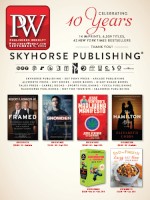In Appetites (Ecco; pub month, Oct.), Bourdain focuses on the food he prepares for family and friends.
Why did you choose to do this cookbook, your second, with a coauthor?
It’s a huge undertaking, and I needed help beyond scaling and testing recipes. I worked with Laurie Woolever, who I’ve worked with for a very long time as well as on the first cookbook. She knows her stuff and we’re very tuned into each other’s tastes.
What was the most difficult recipe to get right?
It would have to be something outside of my comfort zone. The Korean Army Stew or the Bahn Mi. The Laksa. Those are things I’ll never be an expert that. I wanted to offer a representative and non-disgraceful representation of the original. I wouldn’t want to cook my Laksa for a Malaysian grandmother, put it that way.
Laurie said it’d be the Korean Fried Chicken.
Yes! That was the hardest by far. That was entirely Laurie’s work because I knew that was going to be murderous and so difficult. That’s a science experiment.
What made it so difficult?
Getting it crisp. And the interplay between the crispiness and sauce. It’s really tough. A lot of experimentation and failure there.
How long did this book take?
Two years. I’m a big believer in print, and I think this book is in a lot of ways an argument for print. I wanted to make an object that was a thing of wonder, beauty, and strangeness. I wanted to write a cookbook that didn’t look like anybody else’s. I wanted to push the boundaries of what the food should look like.
I was very much influenced by Fergus Henderson’s Nose to Tail where you’d see a thumb on the plate or a dish with a bite taken out. I was really impressed with Marin Picard’s Au Pied du Cochon cookbook. I wanted to take things further. A Ralph Steadman cover and photos of a plate where there’s no food at all would be really interesting and a challenge for a photographer to really cut loose.
I also wanted the book to be more realistic. When we cook at home, our food looks more like the images here than the stuff you see in most cookbooks. As for the text, I wanted to talk to people like they’re adults rather than children. I wanted to say "there’s a reasonable chance you’ll fuck this recipe up the first time. A professional probably would." And that’s fine. Most cookbooks don’t do that. They just offer a hollandaise recipe. They don’t tell you that a professional fucked it up the first time and had to be shown again and again and again until they got it right.
Which brings up the Thanksgiving chapter.
That’s a three-day operation in a restaurant, and it should be a three-day operation at home. If you want to enjoy your Thanksgiving and spend any time with your guests it’s unwieldy. Carving a turkey on the bone? The first person’s food will be cold by the time you get to the last person. What’s the worst thing? Okay, you’re possibly overproducing because you’re roasting another turkey. But the whole point of Thanksgiving is leftovers anyway.
I was surprised to see the admiration for Ina Garten in the book.
It’s not my style by any means, but I respect her abilities as a cook. When Ina cooks a chicken, she does a very respectable job that you’d have to be an asshole to find fault with.
Do you think readers will be surprised that the book includes recipes for tuna salad and macaroni and cheese?
I’m a dad. That’s what I make at home. I like meat loaf just as much as anyone. In fact, more than anyone.
Most chefs I know eat very simply at home and are most sentimental about the things they ate as a child. I liked my mom’s meat loaf. I have a fixed idea of what macaroni and cheese should be like. It makes me happy. It’s comfort food to me.
I think it’s fair for a trained chef to say ‘I like processed cheese in some situations.’ I don’t think you’re improving macaroni and cheese with truffles or lobster or goat cheese. I don’t think they make it better. Macaroni and cheese was perfect!
This is food that I cook for myself, my family and friends. This is an accurate representation of the things I genuinely love to cook when I’m not working. What’s better than tuna salad? A fluffy, mayonnaise-y tuna salad on a piece of generic white bread with a crispy piece of iceberg lettuce. It’s perfect.
It’s also an admission. I will never put sushi in a book of mine. It takes up to seven years to get the fundamentals right. I don’t have that kind of credibility when it comes to sushi.
I think the book is just as—if not more—useful for its strategy and tactics and organization than the usual food porn where you’re looking at dishes you will never make for yourself.
Is that why the dessert chapter consists of a single page advising readers to serve a cheese course?
I just don’t like dessert. I’m not good at pastries. I can’t bake. That might explain my love/hate relationship with pastry chefs. If I had to lose one course for the rest of my life it would be dessert. Just leave me some good cheese. I want to linger over some good port wine and some really stinky, runny cheese. I also don’t expect people to listen to me when I talk about desserts. I’m on record as saying I don’t care about them. Why should you want a bundt cake from me?
This article has been updated with additional material.



 Volume 263
Issue 36
09/05/2016
Volume 263
Issue 36
09/05/2016





